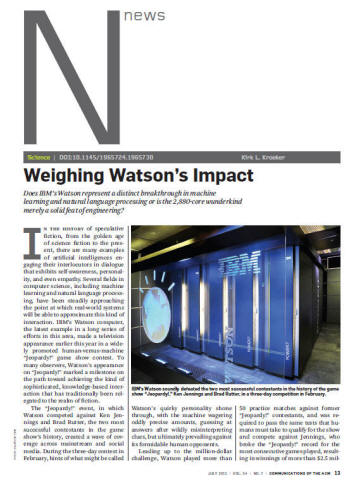|
|
Weighing Watson's Impact
By Kirk L. Kroeker
Does IBM’s Watson represent a distinct
breakthrough in machine learning and natural language
processing or is the 2,880-core wunderkind merely a solid
feat of engineering?
In the history of speculative fiction, from the golden
age of science fiction to the present, there are many
examples of artificial intelligences engaging their
interlocutors in dialogue that exhibits self-awareness,
personality, and even empathy. Several fields in computer
science, including machine learning and natural language
processing, have been steadily approaching the point at
which real-world systems will be able to approximate this
kind of interaction. IBM’s Watson computer, the latest
example in a long series of efforts in this area, made a
television appearance earlier this year in a widely promoted
human-versus-machine “Jeopardy!” game show contest. To many
observers, Watson’s appearance on “Jeopardy!” marked a
milestone on the path toward achieving the kind of
sophisticated, knowledge-based interaction that has
traditionally been relegated to the realm of fiction.
(This article appeared in
CACM, vol. 54, no. 7, July 2011, pp. 13-15, and was
republished in the book Technologies, Social Media, and
Society, McGraw-Hill, 2012.)
(download
the PDF)

|